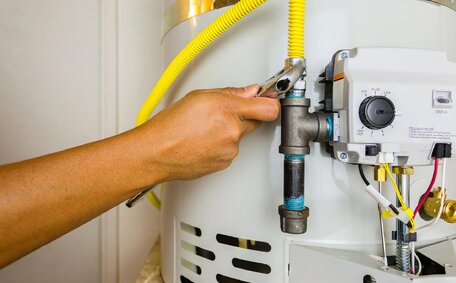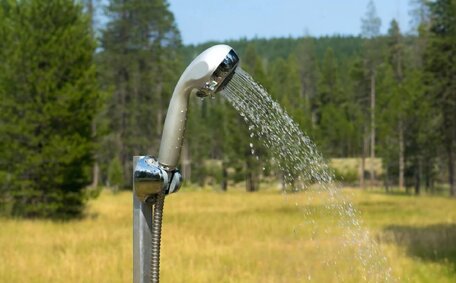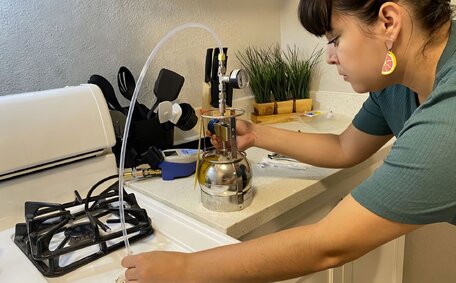Locating Your Home’s Main Water Shutoff Valve
Locating your home’s main water shutoff valve is essential for rapidly disconnecting the water supply in emergencies or during maintenance tasks. This valve, utilised to shut off your water supply, is typically found in one of two places:
- At the property’s boundary, often in a box labelled "W" or "WM" for the water meter. This valve halts the mains water supply, blocking mains water from entering your property.
- Inside the house, the shutoff valve is usually located under the kitchen sink, known as the inside stop valve, to turn off the water supply. This valve shuts off water supplied inside.
To shut off mains water, interior valves like gate valves or ball valves need a straightforward clockwise turn. Locating your home’s hot and cold water shutoff valves and knowing how to operate the main shutoff is essential for future emergencies.
In regions prone to freezing temperatures, the valve may be situated in the basement or crawlspace to lower the risk of pipe freezing. If unsure whether you have a shutoff valve, it’s savvy to contact your local water supplier for confirmation.
Identifying Different Types of Water Shutoff Valves
Gate valves and ball valves are the most commonly found water supply valves within homes. Here’s a breakdown of how turn off water using these different types of valves:
Gate Valves
Gate valves have a wheel-shaped handle that stops the flow of water when turned clockwise. Once the water is off, the gate valve’s handle aligns with the pipe. Gate valves decrease water flow gradually, mitigating the risk of pressure surges.
Ball Valves
Ball valves use a spherical mechanism with a rounded handle that rotates 90 degrees to switch between open and closed. When open, the handle stands perpendicular to the pipe for water flow, and is parallel when closed to stop it. Ball valves can provide quicker shutoff but can cause water hammer if closed too fast.
Familiarising yourself with the shut-off instructions for each valve type and its location is imperative. A firm clockwise turn will switch the water off effectively.
Apply steady, moderate pressure when operating the valve to prevent damage to your fixtures and obviate the need to shut off the water main. If you encounter a stiff valve or leakage that may fail to turn off your water, contact a licenced plumber promptly.
Step-By-Step Guide to Turning Off Your Main Water Supply
Understanding how to disconnect your property’s gas hot water supply is crucial to preventing possible home damage. Follow this step-by-step guide for tankless water heater maintenance, which encompasses locating your internal stop tap:
- Identify the main shut off valve, your central control point, usually found near your property’s front boundary in the meter box or strategically located under the kitchen area.
- Familiarise yourself with the correct technique for turning the valve. A standard valve can be turned clockwise to halt the water flow.
- To ensure all water outlets inside the home are turned off before starting, verify each one individually.
- Place a container under the valve to catch any water released when turning.
- Wear gloves for grip. Turn the valve clockwise slowly and steadily until tight and unable to turn further. Do not over tighten.
- To resume water supply, simply turn valve counter-clockwise, reversing the shutoff process.
- Check the valve every 6 months by turning slightly and returning to fully open. Keeping it functional prevents seizing up when needed.
Incorporating these steps into your routine maintenance allows skillful shutdown of your mains water supply when needed. Should complications arise or concerns nag about your water supply, don’t hesitate to contact a licenced plumber at once.
Turning Off Water to Specific Fixtures and Appliances
Sometimes, it’s necessary to shut off water to specific fixtures or appliances without affecting the whole house’s supply. Reasons could include leaks, repairs, or maintenance.
Sinks, toilets, and hot water systems typically have dedicated shutoff valves for independent water supply regulation.
Locate these valves near the fixture; under sinks or behind toilets. Identify the valve type using the advice provided earlier.
Follow a similar process to shut off an isolation valve:
- Turn off the fixture itself first if possible e.g. shut off taps.
- Place a bucket under valves to catch any excess water released.
- Turn the isolation valve clockwise until tight and water stops flowing out the fixture.
- Turn the fixture back on to ensure water is fully shut off.
- Complete repairs then restore water flow by turning isolation valve counter-clockwise.
Becoming acquainted with your stop tap enables you to control individual fixtures without cutting off the whole household’s water supply. Dedicating time to pinpoint your home’s stop valves ensures you’re ready for any plumbing issue.
Reasons for Turning Off Your Home’s Water Supply
There are several scenarios where turning off your home’s main water supply can be necessary or advisable:
- For plumbing repairs or maintenance, switching off the water supply ensures safe work on pipes and fixtures without the complication of flowing water.
- Burst water pipes or significant water leak - Swiftly shutting off water main can minimise damage and conserve water.
- Preventing leaks while away - If leaving your home vacant while on holidays, turning off water can prevent catastrophic leakage and flooding.
- Freezing weather - In cold climates, shutting off and draining pipes reduces the risk of frozen, ruptured water lines.
Immediate access to your main shutoff valve enables prompt water supply disconnection during emergencies. It also grants peace of mind against costly water damage when undertaking repairs or maintenance to your plumbing system.
We suggest clearly labelling your water shutoff valves and ensuring household members are familiar with their locations and operation. Periodically ensure all valves in your house are in working order and not seized by cycling them closed and open.
Maintaining and Preparing Your Water Shutoff System
Proper upkeep of your home’s main water shutoff system is vital for its dependable function when necessary. Here are some tips:
- Regular six-monthly valve testing prevents the struggle with a balky valve in crucial moments.
- Label the valve with a highly visible tag for easy identification in emergencies.
- Keep the access path clear so you can shut off main water valve quickly. Dispose of any clutter that could be a barrier to promptly shut off main valves in a pinch.
- Installing protective measures like a valve guard can enhance safety around your main water valve.
- In case of a stiff or faulty valve, contact your trusted licenced plumber for assessment and necessary repairs.
- Instruct all household members on valve your home contains and how to operate them. Appoint someone to turn it off during vacations.
- Create an emergency floor plan noting the valve location to assist house sitters.
Taking time to maintain and prepare your home’s water shutoff system grants peace of mind and helps prevent severe water damage from leaks or burst pipes when you need it most.
When to Call a Professional Plumber
While knowing how to operate the main water shutoff valve is helpful, certain situations call for the expertise of a licenced professional plumber. such as the team at Blakehurst Plumbing.
You should contact a plumber if:
- Your valve is stuck and won’t turn off properly, allowing water to continue flowing.
- The valve or adjoining pipes show signs of leakage even when in the 'off’ position.
- You are uncertain about performing any operations covered in this article, like finding isolation valves or interpreting different valve types.
- Your plumbing system experiences unresolved issues that require repair by an expert.
Our licenced and insured plumbers possess the hands-on experience and specialised tools, and they stay current with plumbing codes to efficiently handle issues with shutoff valves or other plumbing challenges.
If you need help managing water flow control in your Sydney home or business, call Blakehurst Plumbing on 1300 349 338 immediately.






